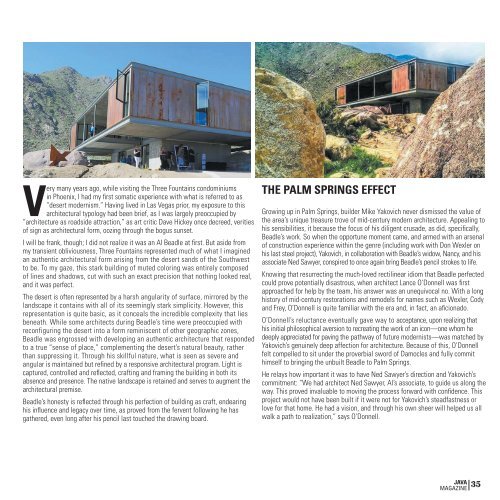Java.March.2017
Create successful ePaper yourself
Turn your PDF publications into a flip-book with our unique Google optimized e-Paper software.
Very many years ago, while visiting the Three Fountains condominiums<br />
in Phoenix, I had my first somatic experience with what is referred to as<br />
“desert modernism.” Having lived in Las Vegas prior, my exposure to this<br />
architectural typology had been brief, as I was largely preoccupied by<br />
“architecture as roadside attraction,” as art critic Dave Hickey once decreed, verities<br />
of sign as architectural form, oozing through the bogus sunset.<br />
I will be frank, though; I did not realize it was an Al Beadle at first. But aside from<br />
my transient obliviousness, Three Fountains represented much of what I imagined<br />
an authentic architectural form arising from the desert sands of the Southwest<br />
to be. To my gaze, this stark building of muted coloring was entirely composed<br />
of lines and shadows, cut with such an exact precision that nothing looked real,<br />
and it was perfect.<br />
The desert is often represented by a harsh angularity of surface, mirrored by the<br />
landscape it contains with all of its seemingly stark simplicity. However, this<br />
representation is quite basic, as it conceals the incredible complexity that lies<br />
beneath. While some architects during Beadle’s time were preoccupied with<br />
reconfiguring the desert into a form reminiscent of other geographic zones,<br />
Beadle was engrossed with developing an authentic architecture that responded<br />
to a true “sense of place,” complementing the desert’s natural beauty, rather<br />
than suppressing it. Through his skillful nature, what is seen as severe and<br />
angular is maintained but refined by a responsive architectural program. Light is<br />
captured, controlled and reflected, crafting and framing the building in both its<br />
absence and presence. The native landscape is retained and serves to augment the<br />
architectural premise.<br />
Beadle’s honesty is reflected through his perfection of building as craft, endearing<br />
his influence and legacy over time, as proved from the fervent following he has<br />
gathered, even long after his pencil last touched the drawing board.<br />
THE PALM SPRINGS EFFECT<br />
Growing up in Palm Springs, builder Mike Yakovich never dismissed the value of<br />
the area’s unique treasure trove of mid-century modern architecture. Appealing to<br />
his sensibilities, it because the focus of his diligent crusade, as did, specifically,<br />
Beadle’s work. So when the opportune moment came, and armed with an arsenal<br />
of construction experience within the genre (including work with Don Wexler on<br />
his last steel project), Yakovich, in collaboration with Beadle’s widow, Nancy, and his<br />
associate Ned Sawyer, conspired to once again bring Beadle’s pencil strokes to life.<br />
Knowing that resurrecting the much-loved rectilinear idiom that Beadle perfected<br />
could prove potentially disastrous, when architect Lance O’Donnell was first<br />
approached for help by the team, his answer was an unequivocal no. With a long<br />
history of mid-century restorations and remodels for names such as Wexler, Cody<br />
and Frey, O’Donnell is quite familiar with the era and, in fact, an aficionado.<br />
O’Donnell’s reluctance eventually gave way to acceptance, upon realizing that<br />
his initial philosophical aversion to recreating the work of an icon—one whom he<br />
deeply appreciated for paving the pathway of future modernists—was matched by<br />
Yakovich’s genuinely deep affection for architecture. Because of this, O’Donnell<br />
felt compelled to sit under the proverbial sword of Damocles and fully commit<br />
himself to bringing the unbuilt Beadle to Palm Springs.<br />
He relays how important it was to have Ned Sawyer’s direction and Yakovich’s<br />
commitment: “We had architect Ned Sawyer, Al’s associate, to guide us along the<br />
way. This proved invaluable to moving the process forward with confidence. This<br />
project would not have been built if it were not for Yakovich’s steadfastness or<br />
love for that home. He had a vision, and through his own sheer will helped us all<br />
walk a path to realization,” says O’Donnell.<br />
JAVA 35<br />
MAGAZINE


















